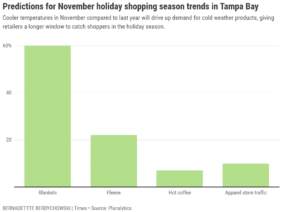How Tampa Bay holiday sales could get a boost from the weather
By Bernadette Berdychowski
Last year’s hurricane season left people with less money to spend for the holidays. But this year is a different story.
The forecast is in — for both the holiday shopping season and the weather. . . .
National holiday sales could break records this year, according to estimates from the National Retail Federation. There’s several reasons why the federation anticipates more spending this year: average household wealth is rising and stores are pushing consumers to start shopping earlier due to supply chain issues.
One other possible factor? La Niña. . . .
. . . The retail federation said this kind of climate pattern typically correlates with stronger retail sales. While it isn’t the only driver, it could help tip the scales for a record year. Experts predict shoppers will spend between $843.4 billion and $859 billion in the 2021 holiday shopping season, 10.5 percent more than last year.
Weather trends are favorable for retailers nationally this time of year, said Evan Gold, executive vice president of Planalytics, a statistics firm measuring weather and its effect on shopping.
But Florida and Tampa Bay are anomalies, Gold said. Not for better or worse — just different. . . .
. . . After Hurricane Eta made landfall north of Tampa Bay last year, Gold said locals had less additional income to spend during the holiday season. Because a storm like Eta hasn’t hit the region this year — though it’s still possible — people have more to spend on gifts.
Local retailers shouldn’t assume a “double dip” La Niña, a term NOAA uses to describe a consecutive year of the weather phenomenon, to predict how consumers will spend this holiday season, Gold said. Weather patterns hardly ever repeat. . . .
. . . What drives a shopper to buy a sweater depends on the market and the time of year, Gold said. A cold front similar to last weekend’s lows of 53 degrees in Tampa is one example of a weather event that would entice Tampa Bay locals to shop for fleece.
“The definition of cold is different in Tampa Bay than Green Bay,” Gold said.
But supply chain shortages could put a damper on things.
“A lot of retailers are talking about the fact that they’re not certain how much inventory they’re going to get and when they’re going to get it,” Gold said. “So they’re encouraging customers to shop as early as they can. So the weather happening right now is going to be a lot more important.”
December, on the other hand, is expected to be warmer than last year, Gold said. Demand for outdoor products like bicycles, sports drinks and fishing gear is expected to be up between 2 and 4 percent from 2020, according to Planalytics data. People are also more likely to spend on items less driven by the weather, such as electronic devices.
“Weather is one of, if not the largest external drivers of demand right now,” Gold said.
It doesn’t only affect what people buy and how much, but also where they shop. And this year, in-person shopping is set to make a comeback. . . .
. . . How the weather turns out could determine how big the effect could be.
The weather in November and December matters much more for businesses than other times of the year, given the impact of the holiday shopping season on retailers’ bottom line. So far, forecasts of a drier climate are expected to boost apparel store traffic 10 percent in November compared to last year, Planalytics data found.
But shoppers, be warned: Chances of finding a good deal on a sweater are less than 50 percent.

